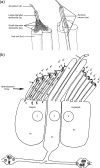Noise-induced hearing loss: new animal models
- PMID: 25111054
- PMCID: PMC4289668
- DOI: 10.1097/MOO.0000000000000086
Noise-induced hearing loss: new animal models
Abstract
Purpose of the review: This article presents research findings from two invertebrate model systems with potential to advance both the understanding of noise-induced hearing loss mechanisms and the development of putative therapies to reduce human noise damage.
Recent findings: Work on sea anemone hair bundles, which resemble auditory hair cells, has revealed secretions that exhibit astonishing healing properties not only for damaged hair bundles, but also for vertebrate lateral line neuromasts. We present progress on identifying functional components of the secretions, and their mechanisms of repair. The second model, the Johnston's organ in Drosophila, is also genetically homologous to hair cells and shows noise-induced hearing loss similar to vertebrates. Drosophila offers genetic and molecular insight into noise sensitivity and pathways that can be manipulated to reduce stress and damage from noise.
Summary: Using the comparative approach is a productive avenue to understanding basic mechanisms, in this case cellular responses to noise trauma. Expanding study of these systems may accelerate identification of strategies to reduce or prevent noise damage in the human ear.
Figures


Similar articles
-
Hair bundles of sea anemones as a model system for vertebrate hair bundles.Hear Res. 1997 May;107(1-2):53-66. doi: 10.1016/s0378-5955(97)00022-1. Hear Res. 1997. PMID: 9165347
-
Anatomical and functional recovery of the goldfish (Carassius auratus) ear following noise exposure.J Exp Biol. 2006 Nov;209(Pt 21):4193-202. doi: 10.1242/jeb.02490. J Exp Biol. 2006. PMID: 17050834
-
Mechanical overstimulation causes acute injury and synapse loss followed by fast recovery in lateral-line neuromasts of larval zebrafish.Elife. 2021 Oct 19;10:e69264. doi: 10.7554/eLife.69264. Elife. 2021. PMID: 34665127 Free PMC article.
-
Using Drosophila to study mechanisms of hereditary hearing loss.Dis Model Mech. 2018 May 31;11(6):dmm031492. doi: 10.1242/dmm.031492. Dis Model Mech. 2018. PMID: 29853544 Free PMC article. Review.
-
Hearing in Drosophila: development of Johnston's organ and emerging parallels to vertebrate ear development.Dev Dyn. 2005 Mar;232(3):550-8. doi: 10.1002/dvdy.20207. Dev Dyn. 2005. PMID: 15704117 Review.
Cited by
-
Impact of noise on development, physiological stress and behavioural patterns in larval zebrafish.Sci Rep. 2021 Mar 23;11(1):6615. doi: 10.1038/s41598-021-85296-1. Sci Rep. 2021. PMID: 33758247 Free PMC article.
-
Otoprotective Effects of Stephania tetrandra S. Moore Herb Isolate against Acoustic Trauma.J Assoc Res Otolaryngol. 2018 Dec;19(6):653-668. doi: 10.1007/s10162-018-00690-3. Epub 2018 Sep 5. J Assoc Res Otolaryngol. 2018. PMID: 30187298 Free PMC article.
-
A nonneural miRNA cluster mediates hearing via repression of two neural targets.Genes Dev. 2023 Dec 26;37(21-24):1041-1051. doi: 10.1101/gad.351052.123. Genes Dev. 2023. PMID: 38110249 Free PMC article.
-
Hearing in Drosophila.Curr Opin Neurobiol. 2015 Oct;34:79-85. doi: 10.1016/j.conb.2015.02.001. Epub 2015 Feb 22. Curr Opin Neurobiol. 2015. PMID: 25710304 Free PMC article. Review.
-
Physiological Basis of Noise-Induced Hearing Loss in a Tympanal Ear.J Neurosci. 2020 Apr 8;40(15):3130-3140. doi: 10.1523/JNEUROSCI.2279-19.2019. Epub 2020 Mar 6. J Neurosci. 2020. PMID: 32144181 Free PMC article.
References
-
- Watson GM, Mire-Thibodeaux P. The cell biology of nematocysts. Int. Rev. Cytol. 1994;156:275–300. - PubMed
-
- Mire P, Nasse J. Hair bundle motility induced by chemoreceptors in anemones. Hear Res. 2002;163:111–120. - PubMed
-
- Watson GM, Mire P. A Comparison of Hair Bundle Mechanoreceptors in Sea Anemones and Vertebrate Systems. Curr. Top. Dev. Biol. 1999;43:51–84. - PubMed
-
- Watson GM, Mire P, Hudson RR. Hair bundles of sea anemones as a model system for vertebrate hair bundles. Hear Res. 1997;107:53–66. - PubMed
-
- Mire P, Watson GM. Mechanotransduction of hair bundles arising from multicellular complexes in anemones. Hear Res. 1997;113:224–234. - PubMed
Publication types
MeSH terms
Grants and funding
LinkOut - more resources
Full Text Sources
Other Literature Sources
Molecular Biology Databases
Research Materials
